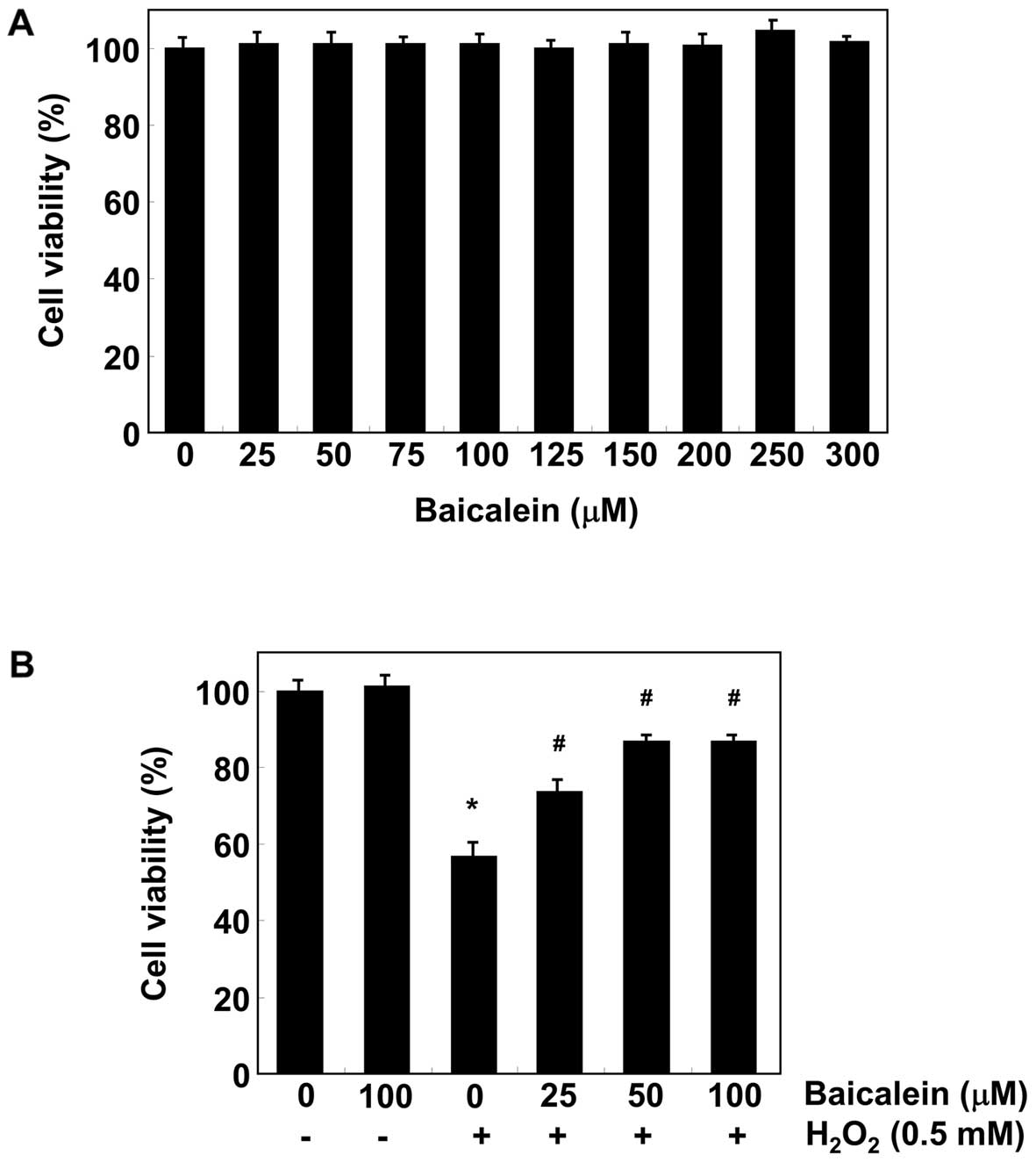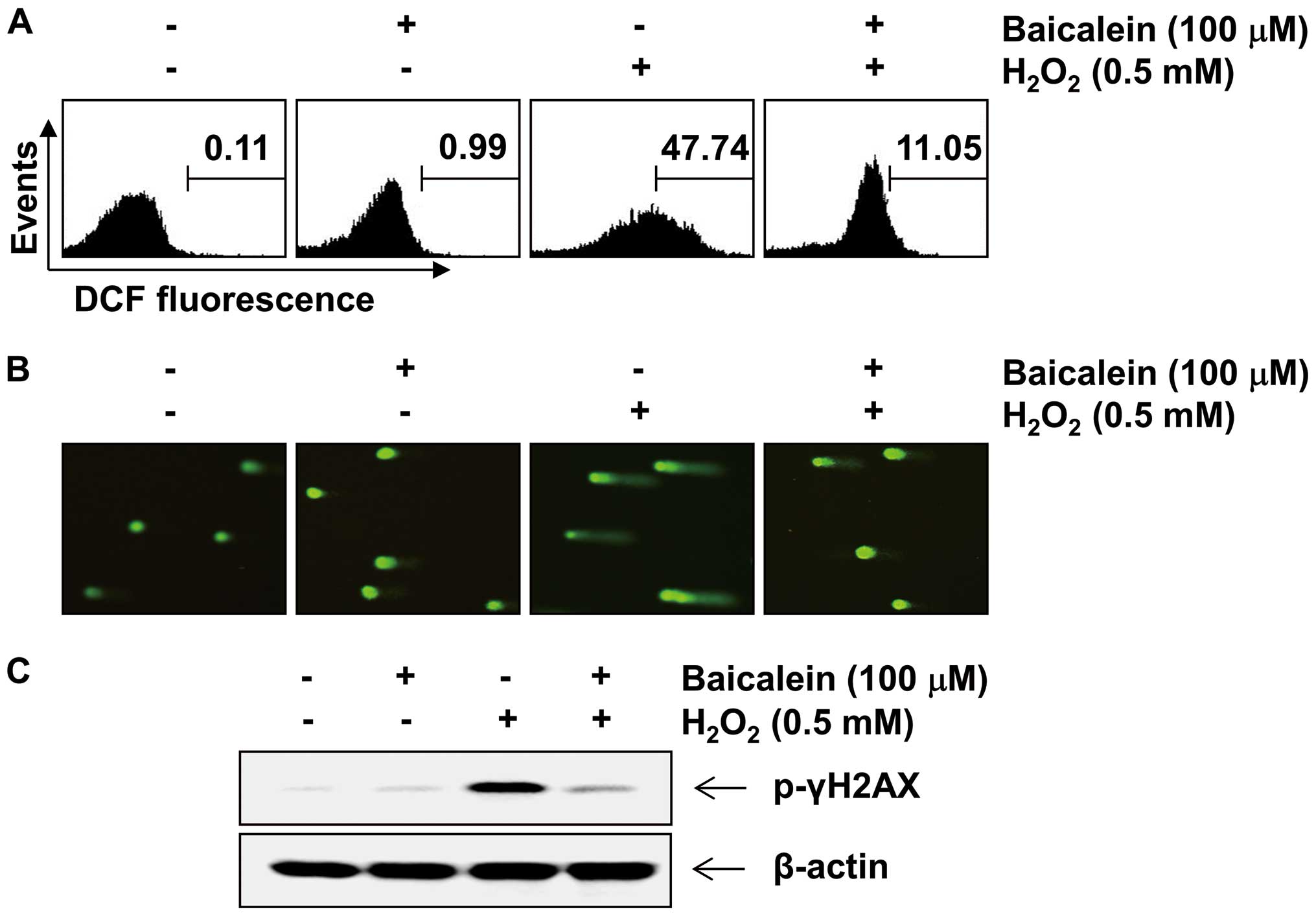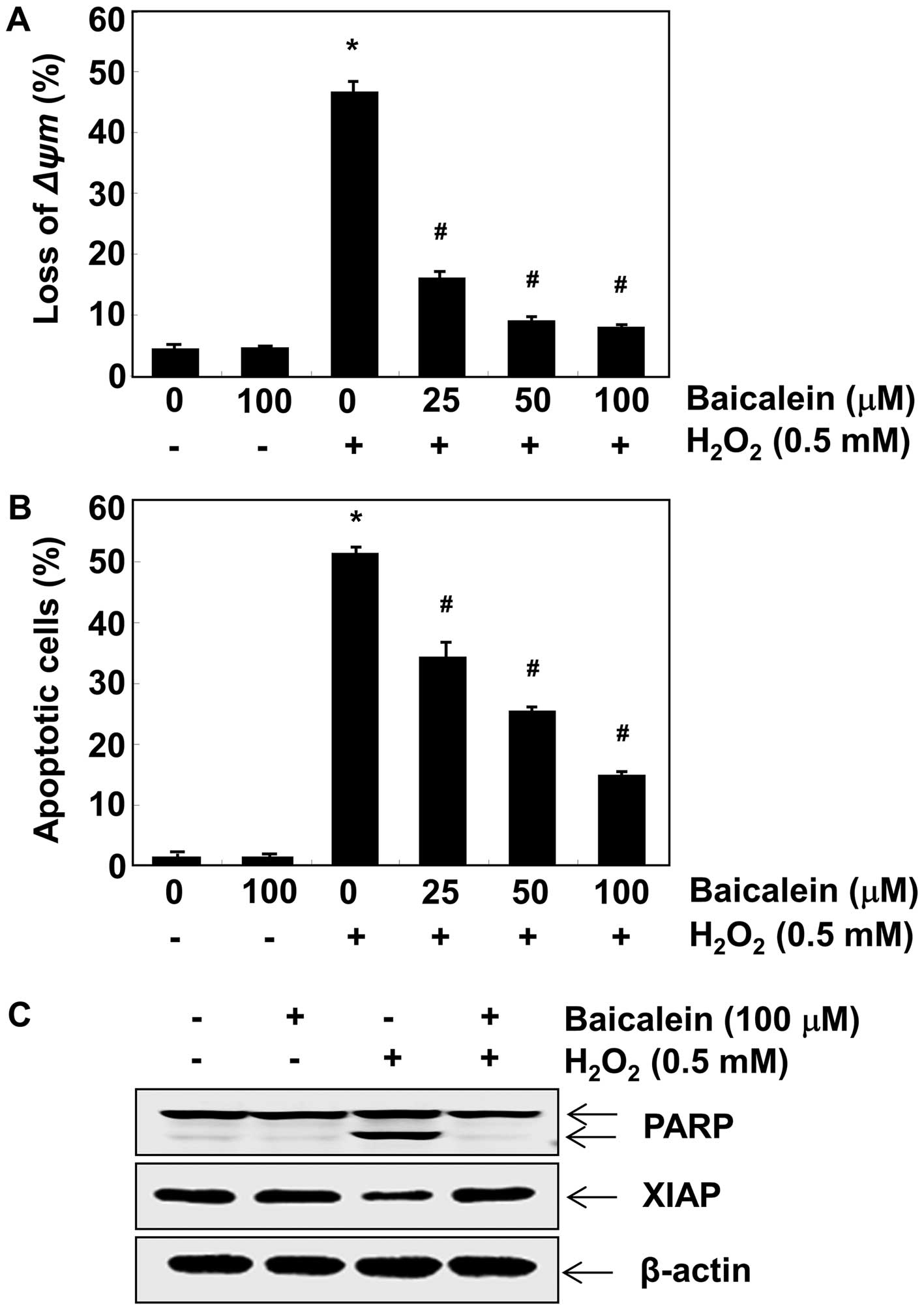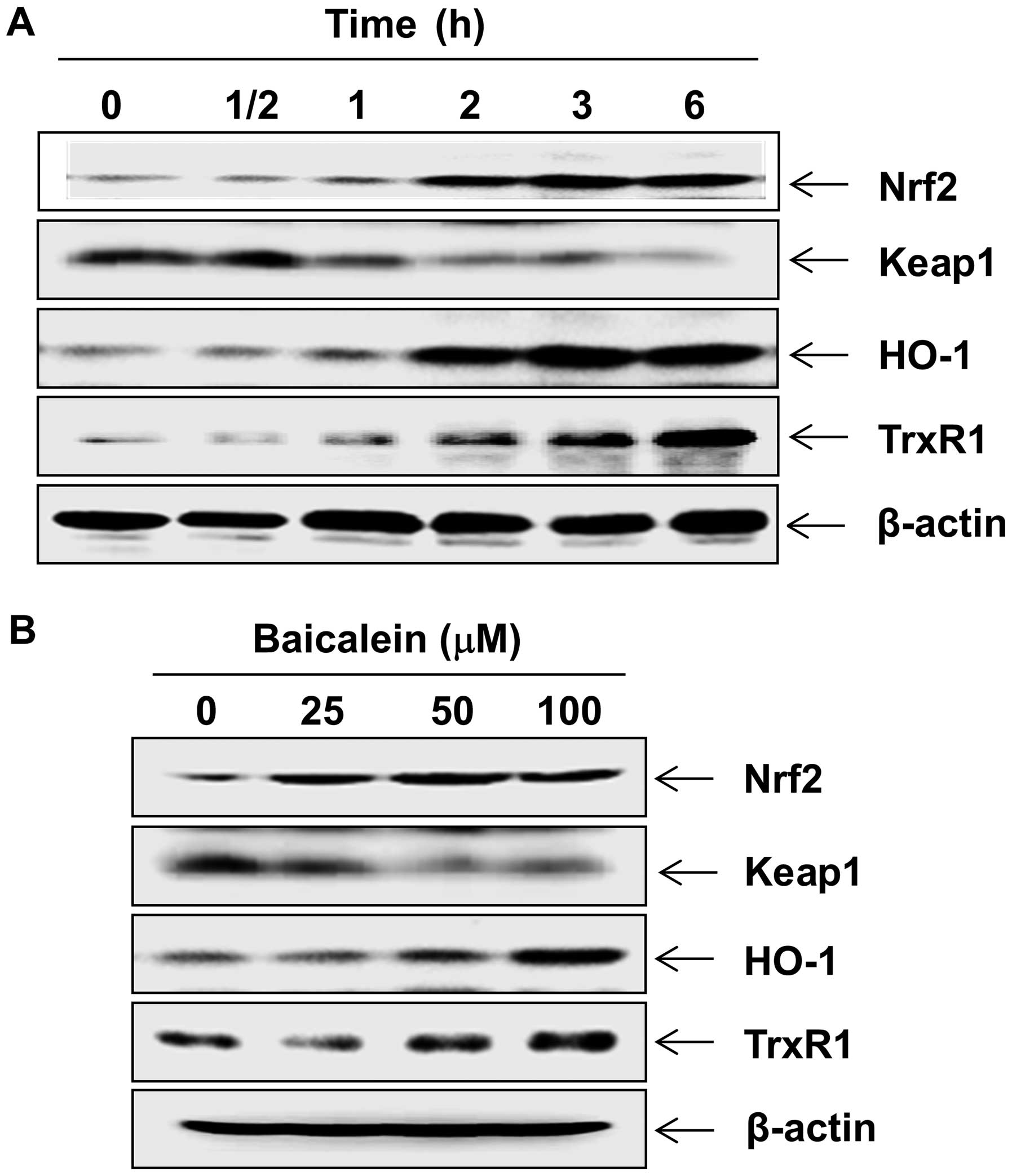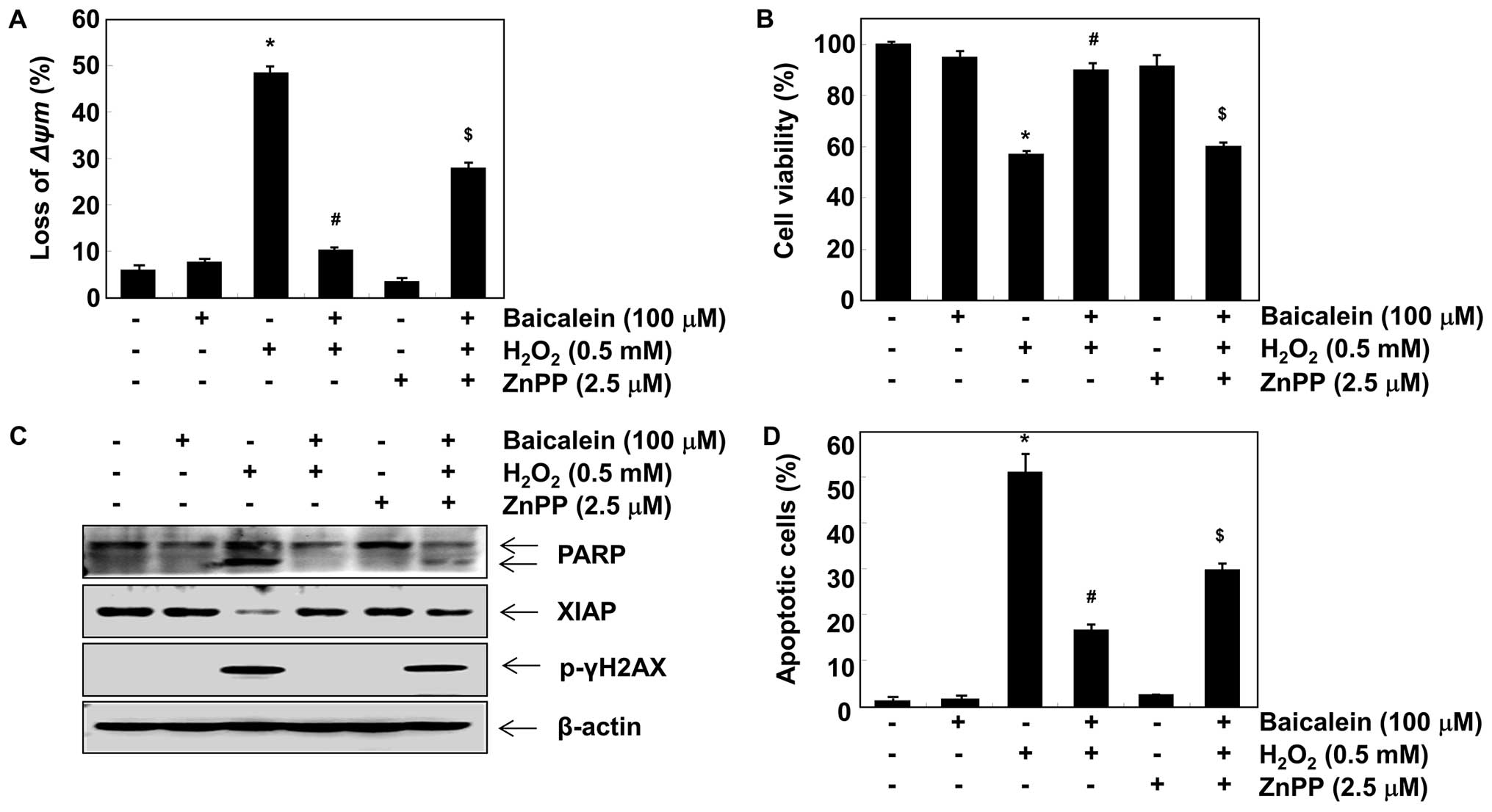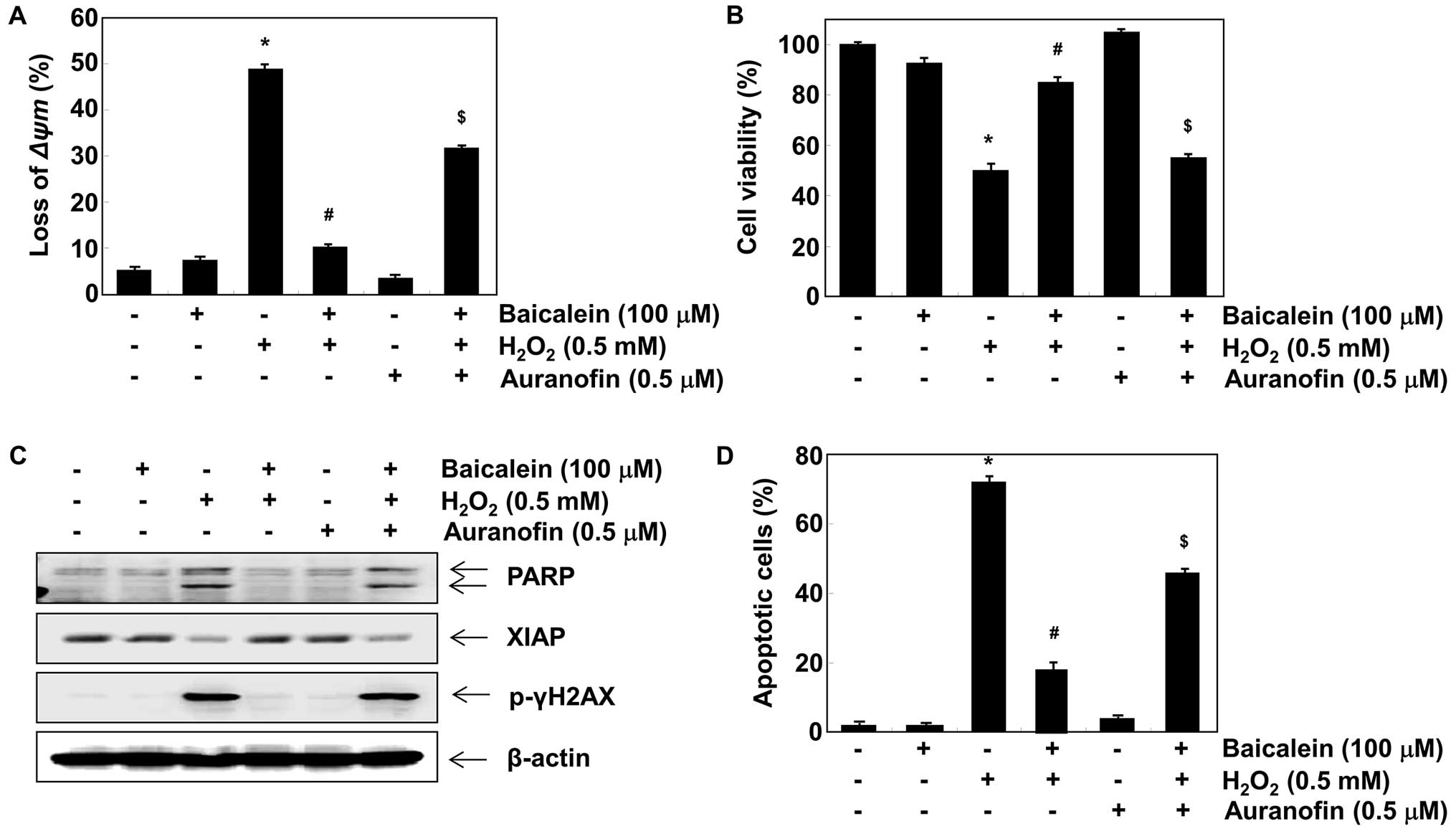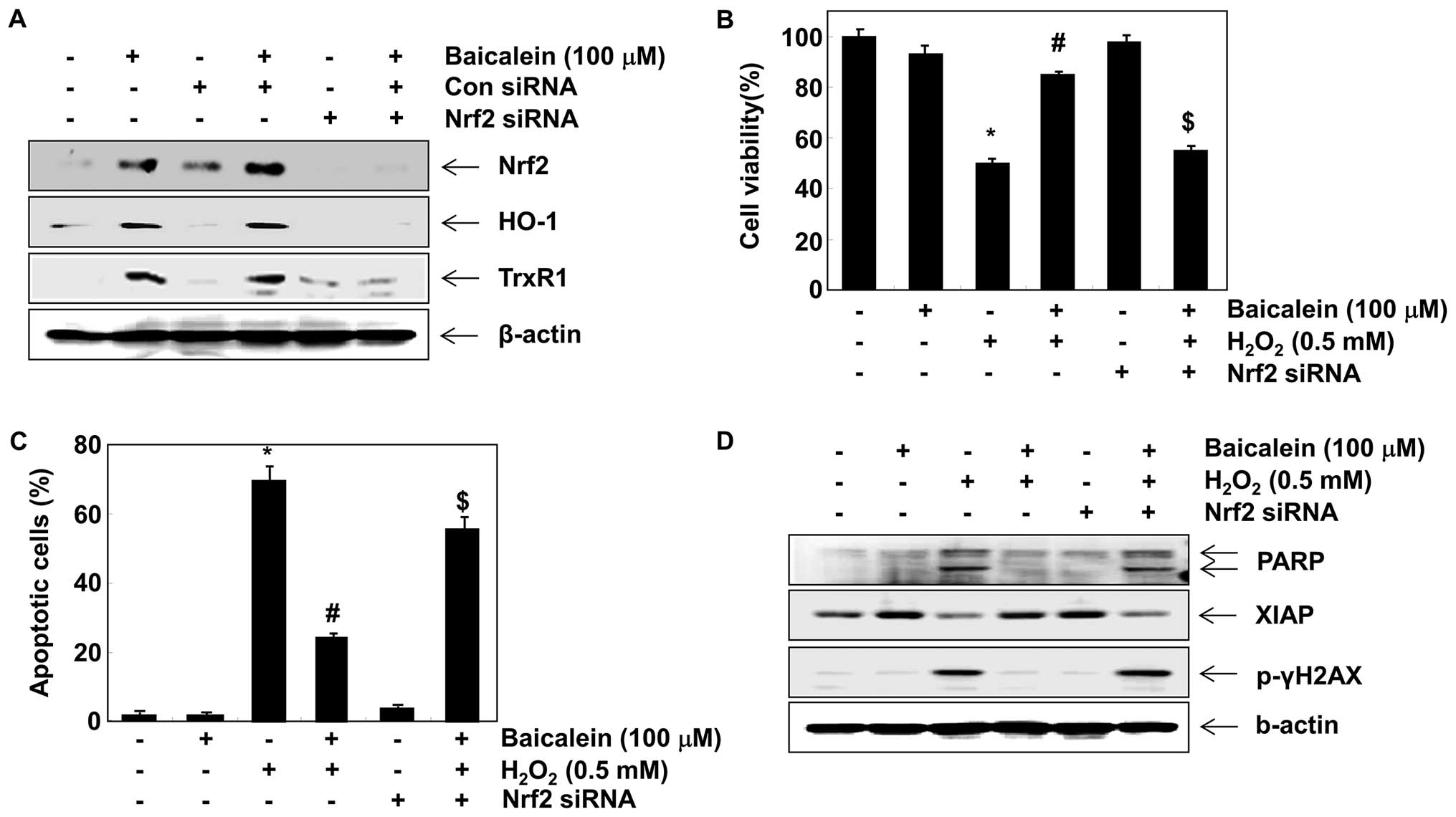Baicalein protects C6 glial cells against hydrogen peroxide-induced oxidative stress and apoptosis through regulation of the Nrf2 signaling pathway
- Authors:
- Published online on: January 20, 2016 https://doi.org/10.3892/ijmm.2016.2460
- Pages: 798-806
Abstract
Introduction
Reactive oxygen species (ROS), such as hydrogen peroxide (H2O2), are generated during normal cellular metabolism, and they play critical roles in the signal transmission mechanism (1,2). However, H2O2 also exerts genotoxicological effects, as it produces new free radicals and causes damage to the main cellular components (3,4). Moreover, the excess production of ROS increases oxidative damage, leading to cellular dysfunction and cell death (5,6). Oxidative stress is mainly caused by neurodegenerative disorders, including dementia, which has attracted significant attention; as brain cells are damaged, the interaction between neurons is inhibited, resulting in disability of memory and cognitive functions (7,8). Glial cells, which outnumber neurons in the brain, are non-neuronal cells that maintain homeostasis as well as supporting and protecting neurons in the central nervous system (CNS) (9). Therefore, the attenuation of oxidative stress and the inhibition of apoptosis in glial cells are critical for protection from neurodegenerative disorders. Thioredoxin reductase 1 (TrxR1) is a nicotinamide adenine dinucleotide phosphate (NADPH)-dependent oxidoreductase that decreases the active site of cytosolic thioredoxin-1 (Trx1) from the disulfide form to the biologically active dithiol form (10). Trx1 contributes to antioxidative activity by donating electrons to peroxiredoxins for the reduction of H2O2 (11,12).
In addition, the heme oxygenase (HO) pathway has been reported to be active in the CNS and to operate as an underlying protective mechanism of cells exposed to an oxidizing agent (13). Moreover, the enhancement of HO-1 protein expression has been associated with protection against stress conditions, such as oxidative stress (14). HO-1 gene expression is mainly regulated by the nuclear factor-erythroid 2-related factor 2 (Nrf2)-antioxidant response element (ARE) pathway, and the induction of this enzyme protects cells against oxidative stress-induced damage and apoptosis (15,16). The Kelch-like ECH-associated protein-1 (Keap1) controls Nrf2 activation and nuclear accumulation by binding to the Nrf2 protein and targeting it for proteosomal degradation (17). Nrf2 is released from Keap1 repression under conditions of oxidative stress, and it translocates to the nucleus where it increases several antioxidant genes, such as HO-1 and TrxR1 (15,18,19). Thus, we suggest that the activation of Nrf2 is crucial for the cytoprotective mechanism against oxidative stress.
Baicalein, a flavonoid originally obtained from the roots of a traditional Chinese herb, Scutellaria baicalensis Georgi, has been widely used in the treatment of inflammation, hypertension, cardiovascular disease, bacterial infection and cancer (20,21). Moreover, the neuroprotective effects of baicalein have been demonstrated in several experimental models, such as models of Alzheimer's disease (22,23), ischemic stroke (24,25), and Parkinson's disease (26,27). However, an association between the Nrf2 pathway with the neuroprotective role of baicalein against oxidative stress in glial cells has not previously been demonstrated. Thus, in the present study, we investigated the neuroprotective effect exerted by baicalein and also its mechanisms which protect against H2O2-induced neuronal damage in a model using C6 glial cells.
Materials and methods
Reagents and antibodies
In the present study, Dulbecco's modified Eagle's medium (DMEM), fetal bovine serum (FBS), and antibiotics (penicillin and streptomycin) were all purchased from Welgene, Inc. (Daegu, Korea). Baicalein (5,6,7-trihydroxyflavone; purity 98%), H2O2, 3-(4,5-dimethylthiazol-2-yl)-2,5-diphenyltetrazolium bromide (MTT), propidium iodide (PI), 5,5′,6,6′-tetrachloro-1,1′,3,3′-tetraethylbenzimidazo-lylcarbocyanine-iodide (JC-1), zinc protoporphyrin (ZnPP) IX and auranofin were all purchased from Sigma Chemical Co. (St. Louis, MO, USA); 2′,7′-dichlorofluorescein diacetate (DCFH-DA) was obtained from Molecular Probes, Inc. (Eugene, OR, USA); primary antibody against phosphorylated histone variant H2A.X (p-γH2A.X; #9718) was obtained from Cell Signaling Technology, Inc. (Danvers, MA, USA); β-actin (sc-1616), poly(ADP-ribose) polymerase (PARP; sc-7150), X-linked inhibitor of apoptosis protein (XIAP; sc-11426), Nrf2 (sc-13032), Keap1 (sc-15246), HO-1 (sc-7696) and TrxR1 (sc-28321) antibodies were all purchased from Santa Cruz Biotechnology, Inc. (Santa Cruz, CA, USA). The secondary antibodies against goat anti-rabbit IgG-HRP (sc-2004), goat anti-mouse IgG-HRP (sc-2005) and bovine anti-goat IgG-HRP (sc-2350) were all purchased from Santa Cruz Biotechnology, Inc.
Cell culture and treatment
C6 glial cells were obtained from the American Type Culture Collection (ATCC; Manassas, VA, USA) and maintained in DMEM supplemented with 10% heat-inactivated FBS and antibiotics (100 µg/ml streptomycin, 100 U/ml penicillin) at 37°C in a humidified incubator in an atmosphere of 5% CO2 in air. Baicalein was dissolved in dimethyl sulfoxide (DMSO) as a stock solution at 100 mM, which was then diluted with DMEM to the desired concentration prior to use. H2O2 was diluted in DMEM to a final concentration of 0.5 mM.
Cell viability assay
C6 cells were seeded in 6-well plates at a density of 2x105 cells/well. After incubation for 24 h, the cells were pretreated with various concentrations of baicalein for 1 h prior to incubation in the absence or presence of H2O2 for 24 h. An MTT working solution (0.5 mg/ml) was added to the culture plates and incubated for 3 h at 3°C. The culture supernatant was removed from the wells, and DMSO was added to dissolve the formazan crystals completely. The absorbance of each well was measured at 540 nm using a microplate reader (Dynatech Laboratories, Chantilly VA, USA). The effect of baicalein on cell growth was assessed as the percentage of cell viability, in which the vehicle-treated cells (0.05% DMSO) were considered 100% viable.
Comet assay (single-cell gel electrophoresis)
The cell suspension was mixed with 0.5% low melting agarose (LMA) at 37°C, and the mixture was spread on fully frosted microscopic slides pre-coated with 1% normal melting agarose. After solidification of the agarose, the slides were covered with 0.5% LMA and then immersed in a lysis solution (2.5 M NaCl, 100 mM Na-ethylenediaminetetraacetic acid (EDTA), 10 mM Tris, 1% Triton X-100, and 10% DMSO, pH 10.0) for 30 min at 4°C. The slides were then placed in a CometAssay Electrophoresis System Starter Kit (KORMED, Seongnam, Korea) containing 300 mM NaOH and 10 mM Na-EDTA (pH 13.00) for 40 min to allow for DNA unwinding and examination of alkali-labile damage. An electrical field was then applied (300 mA, 20 V) for 20 min at 4°C to draw the negatively charged DNA toward the anode. After electrophoresis, the slides were washed three times for 5 min at 4°C in a neutralizing buffer (0.4 M Tris, pH 7.5). The slides were then stained with 20 µg/ml PI and observed using a fluorescence microscope (Carl Zeiss, Inc., Oberkochen, Germany). The images were also analyzed using an image analysis system (Komet 5.5; Kinetic Imaging, Liverpool, UK) to evaluate the degree of DNA damage. The tail length and the tail moment were used as measures of the extent of DNA damage. One hundred cells were randomly selected from one sample (two slides were made for one sample, 50 randomly selected cells per slide) and then measured. We calculated the values of the mean tail length for each sample and the percentage values of the cells in five ranges of tail length: undamaged cells without a tail, cells with a tiny tail, cells with a dim tail (28), cells with a clear tail, and only tail. The ranges of tail length and tail moment were divided arbitrarily in the present study.
Measurement of intracellular ROS
To assess the generated ROS, the cells were incubated with 10 µM DCFH-DA for 20 min at room temperature in the dark to monitor ROS production. ROS levels in the cells were monitored with a flow cytometer (Becton-Dickinson, San Jose, CA, USA) using CellQuest Pro software, as previously described (29).
Measurement of apoptosis
For quantitative assessment of the induced cell apoptotic rate, a fluorescein-conjugated Annexin V (Annexin V-FITC) staining assay was performed according to the manufacturer's instructions (BD Biosciences Pharmingen, San Jose, CA, USA). Briefly, the cells in each sample were stained with 5 µl Annexin V-FITC and 5 µl PI. After incubation for 15 min at room temperature in the dark, the degree of apoptosis was quantified by flow cytometer as a percentage of the Annexin V-positive and PI-negative cells (Becton-Dickinson) using CellQuest Pro software (29).
Measurement of mitochondrial membrane potential (MMP; ΔΨm)
The mitochondrial transmembrane electrochemical gradient was measured using JC-1 staining. Briefly, the cells were collected and incubated with 10 µM JC-1 solution for 15 min at 37°C in the dark. The fluorescence intensity of the red/green ratio was quantified by flow cytometer (Becton-Dickinson) using CellQuest Pro software, as previusly described (30).
Protein extraction and western blot analysis
After removing the media, the cells were washed with ice-cold phosphate-buffered saline (PBS) and gently lysed for 20 min in an ice-cold lysis buffer (40 mM Tris, pH 8.0, 120 mM, NaCl, 0.5% nonidet-P40, 0.1 mM sodium orthovanadate, 2 µg/ml leupeptin, and 100 µg/ml phenymethylsulfonyl fluoride). The supernatants were collected, and the protein concentrations were determined using a Bio-Rad protein assay kit (Bio-Rad Laboratories, Inc., Hercules, CA, USA). For western blot analysis, equal amounts of protein extracts were denatured by boiling at 95°C for 5 min in a sample buffer [0.5 M Tris-HCl, pH 6.8, 4% sodium dodecyl sulfate (SDS), 20% glycerol, 0.1% bromophenol blue and 10% β-mercaptoethanol] at a ratio of 1:1. The samples were stored at −80°C or immediately used for western blot analysis. Aliquots containing 30 µg of total protein were separated by denaturing SDS-polyacrylamide gel electrophoresis and transferring electrophoretically to nitrocellulose membranes (Amersham Biosciences, Arlington Heights, IL, USA). The membranes were then blocked with 5% skim milk and incubated overnight at 4°C with primary antibodies, probed with enzyme-linked secondary antibodies for 1 h at room temperature, and detected using an enhanced chemiluminescence (ECL) detection system (both from Amersham Biosciences).
Small interfering RNA (siRNA) transfection
Nrf2 siRNA and control siRNA were both purchased from Santa Cruz Biotechnology, Inc. The siRNAs were transfected into C6 cells according to the manufacturer's instructions using Lipofectamine® RNAiMAX transfection reagent (Invitrogen, Carlsbad, CA, USA). The cells were seeded in 6-well culture plates for transfection and incubated with 50 nM control or Nrf2 siRNA for 24 h in serum-free OPTI-MEM media (Invitrogen). After 24 h transfection, the cells were incubated under the experimental conditions.
Statistical analysis
Data are expressed as the means ± standard error of the mean (SEM). The comparison between groups was undertaken using ANOVA, and significance was analyzed using Duncan's multiple range test. A P-value <0.05 was considered to indicate a statistically significant difference.
Results
Baicalein prevents H2O2-induced growth inhibition in C6 cells
We first determined the effect of baicalein on the viability of C6 cells using the MTT assay. As shown in Fig. 1A, the results demonstrated that baicalein (25–300 µM) alone for 24 h had no detectable effect on C6 cell survival. To determine the protective effects of baicalein on H2O2-induced cytotoxicity in C6 cells, the cells were pre-treated with baicalein for 1 h and exposed to H2O2 for an additional 24 h. As shown in Fig. 1B, the treatment of C6 cells with 0.5 mM H2O2 for 24 h resulted in approximately a 43% loss of cellular viability compared with the control cells. However, the cytotoxic effect of H2O2 was blocked by pretreating cells with baicalein (25–100 µM).
Baicalein attenuates H2O2-induced ROS generation and DNA damage in C6 cells
To examine the inhibitory effect of baicalein on H2O2-induced ROS production, C6 cells were stimulated with 0.5 mM H2O2 for 30 min in the presence and absence of baicalein, and the intracellular ROS level was then determined. As expected, increased ROS generation was detected in cells after stimulation with H2O2 alone (Fig. 2A). However, pretreatment with baicalein significantly reduced H2O2-induced ROS production. We further examined the effects of baicalein on DNA damage caused by H2O2 using a Comet assay and western blot analysis. As indicated in Fig. 2B, treatment with H2O2 alone significantly increased the number of DNA breaks, resulting in an increase in fluorescence intensity in the tails of the comet-like structures, which was associated with an increase in the tail length and tail moment (Table I). However, these phenomena were prevented by pretreatment with baicalein. In addition, the western blot analysis revealed that the level of p-γH2A.X, a classic marker of DNA double-strand break formation (31), in C6 cells treated with H2O2 alone was markedly increased. However, pretreatment with baicalein was found to inhibit the increase in p-γH2A.X expression caused by treatment with H2O2 (Fig. 2C).
Baicalein reduces H2O2-induced loss of MMP and apoptosis in C6 cells
As mitochondrial permeability is critical for the oxidative stress-induced apoptotic pathway (32), we evaluated the effect of baicalein on the MMP of C6 cells using flow cytometry. After incubation with H2O2 alone, the loss of MMP was markedly increased compared to the untreated control (Fig. 3A), which indicated mitochondrial damage and dysfunction. By contrast, pretreatment with baicalein effectively prevented the loss of MMP induced by H2O2 in a concentration-dependent manner. We also examined the ability of baicalein to protect against H2O2-triggered C6 cell apoptosis using Annexin V/PI-staining. The flow cytometry results indicated that the percentage of apoptotic cells treated with 0.5 mM H2O2 was approximately 51% (Fig. 3B), which was significantly reduced by pretreatment with baicalein. Furthermore, we determined the effects of baicalein on the expression of apoptosis-related proteins PARP and XIAP. As illustrated in Fig. 3C, the degradation of PARP and the downregulation of XIAP were observed in H2O2-treated C6 cells. However, pretreatment with baicalein effectively protected against these changes.
Baicalein upregulates Nrf2, HO-1 and TrxR1 expression in C6 cells
The fact that Nrf2 signaling regulates cellular antioxidant response has been well documented (33). We sought to determine whether signaling was associated with baicalein-mediated neuroprotection. Western blot analysis indicated that treating C6 cells with baicalein induced the expression of Nrf2 protein in a concentration- and time-dependent manner, which was associated with the downregulation of Keap1 (Fig. 4). Concomitant with the induction of Nrf2, the levels of HO-1 and TrxR1 were also markedly increased after treatment with baicalein in C6 cells.
Induction of HO-1 and TrxR1 is involved in the protective effect exerted by baicalein against H2O2 treatment in C6 cells
In order to investigate the role of HO-1 induction in the baicalein-mediated neuroprotective effects exerted against oxidative stress, we inhibited HO-1 activity using ZnPP, a specific inhibitor of HO-1. As shown in Fig. 5A and B, in the presence of ZnPP, the protective effects of baicalein on H2O2-induced loss of MMP and reduction of cell viability were significantly attenuated. Furthermore, ZnPP blocked the protection provided by baicalein against H2O2-induced degradation of PARP, phosphorylation of γH2A.X, and downregulation of XIAP as well as apoptosis (Fig. 5C and D). To determine whether the protective effect of baicalein was related to its inductive effect on TrxR1 expression, we blocked TrxR1 activity using auranofin, a selective TrxR1 inhibitor. The results indicated that auranofin also reversed the inhibition of loss of MMP and apoptotic activity caused by baicalein in H2O2-stimulated C6 cells (Fig. 6).
Baicalein upregulates HO-1 and TrxR1 expression via Nrf2 activation in C6 cells
It has previously been reported that HO-1 and TrxR1 are regulated through the Nrf2 cascade (19,34–36). We developed an Nrf2 gene knockdown model using siRNA transfection to demonstrate the contribution of Nrf2 signaling to the negative effects of baicalein on H2O2-induced cytotoxicity. Western blot analysis indicated that Nrf2 siRNA reduced the baicalein-induced expression of Nrf2 compared with untransfected control and control siRNA-transfected cells) (Fig. 7A). The baicalein-induced expression of HO-1 and TrxR1 was also blocked by Nrf2 siRNA, which is evidence that the augmentation of HO-1 and TrxR1 was mediated by Nrf2. Furthermore, Nrf2 siRNA significantly attenuated the protective effects of baicalein against the H2O2-induced reduction of cell viability and apoptosis (Fig. 7B and C), which was associated with the disappearance of the potential of baicalein to protect against H2O2-induced PARP degradation, γH2A.X phosphorylation and XIAP reduction (Fig. 7D).
Discussion
The excessive production of ROS, which causes oxidative damage to proteins, lipids and DNA, is one of the most prominent factors related to neurodegeneration (37). The mitochondrial electron transport system is a major source of intracellular ROS generation (32), whereby the mitochondria play a pivotal role in the process of ROS-mediated cell death. Moreover, H2O2 directly induces mitochondrial dysfunction, followed by a rapid efflux of intracellular ROS, which increases the permeabilization and depolarization of the mitochondrial membrane. This event likely facilitates the rapid disruption of MMP and the release of apoptosis-inducing factors that activate the caspase-dependent signaling cascades in the induction of apoptosis (38). Therefore, the search for functional food or bioactive compounds that act against oxidative stress is critical for the prevention and cure of neurodegenerative disorders. The purpose of the present study was to determine whether baicalein blocked H2O2-induced oxidative stress in C6 cells or not. The results demonstrated that treatment of C6 cells with H2O2 caused the marked intracellular accumulation of ROS and the loss of MMP, and further inhibited cell survival, leading to apoptosis. However, when the C6 cells were pretreated with baicalein, the H2O2-induced generation of ROS, loss of MMP, reduction of cell viability, and apoptosis were significantly attenuated, as previously reported in studies on other neuron-like cells (27). Thus, we presume that baicalein improves mitochondrial function through eliminating the overproduction of ROS induced by H2O2 and thereby reducing H2O2-induced apoptosis. In addition, our results showed that H2O2 treatment increased DNA tail moment and length in the comet assay and expression of p-γH2A.X, which are widely used markers for the detection of DNA damage (31). However, in the present study, both events were abolished by baicalein, indicating that it protected against H2O2-induced apoptosis in the C6 cells by reducing the amount of DNA damage caused by the destructive impact of oxidative stress in the C6 cells.
Apoptosis, which is programmed cell death, is a tightly regulated cell suicide response that facilitates the correct development and homeostasis of multicellular organisms; in mammalian cells, two major apoptotic pathways (the cell death receptor-mediated and mitochondrial-mediated apoptotic pathways) have been studied (39). Previous research has indicated that the impairment of MMP and ROS generation is closely linked to the initiation of caspase-dependent apoptotic signaling in many types of cells (5). Caspases, which are a family of cysteine acid proteases, are the central regulators of the execution of cell death in response to various apoptotic stimuli (40). In the final stage of apoptosis, both pathways induce the activation of executioner caspases, such as caspase-3 and -7, which results in the degradation of substrate proteins, such as PARP, a biochemical hallmark of cell apoptosis (39). The activation of caspases may also be regulated by a variety of proteins, including members of the inhibitor of apoptosis proteins (IAP) family, which promote cell survival after a wide variety of apoptotic stimuli elicited via intrinsic and extrinsic pathways through selectively binding with caspases, thus inhibiting caspase activity and apoptosis (39). Moreover, previous research has indicated that H2O2 induces apoptosis through the activation of caspases in addition to the inhibition of IAP family proteins (41). In the present study, western blot analyses revealed that baicalein effectively blocked the H2O2-induced cleavage of PARP, a downstream target protein of the activated caspase-3 in C6 cells. Under the same conditions, baicalein also rescued the H2O2-induced downregulation of XIAP, a representative member of the IAP family, compared with the control. Although further molecular studies are needed, our findings indicate that baicalein potentially prevents H2O2-induced apoptosis through the inactivation of caspase cascades in C6 cells.
Previous research has suggested that Nrf2, a master cellular sensor for oxidative stress, and its repressor, Keap1, play indispensable roles in protecting a variety of tissues from a wide array of toxic insults, including oxidative stress. Under normal conditions, Nrf2 is inactive and bound in the cytosol by Keap1 (35). The dissociation of Nrf2 from Keap1 is a prerequisite for nuclear translocation, and the subsequent DNA binding of Nrf2 is necessary to regulate the inducible expression of cytoprotective phase II enzymes (15,18). In the present study, we found that baicalein increased Nrf2 protein expression and decreased Keap1 in a concentration- and time-dependent manner in C6 cells. These results are consistent with those of previous studies (42–44), and were associated with the induction of HO-1 and TrxR1. However, the inhibition of HO-1 function using ZnPP significantly weakened the inhibitory effects of baicalein on H2O2-induced MMP loss, growth inhibition, and apoptosis by blocking PARP cleavage, XIAP inhibition, and γH2A.X phosphorylation. Moreover, pre-treatment with a TrxR1 inhibitor also markedly abrogated the protective effects of baicalein against H2O2-induced oxidative stress. In addition, the knockdown of Nrf2 by Nrf2-targeted siRNA completely cancelled out baicalein-induced HO-1 and TrxR1 expression, suggesting that Nrf2 is a critical upstream regulator of the baicalein-mediated induction of HO-1 and TrxR1. Furthermore, the removal of Nrf2 also halted the baicalein-induced restoration of H2O2-mediated growth inhibition and the apoptosis of C6 cells. These results suggest that the Nrf2-dependent induction of HO-1 and TrxR1 by baicalein, at least in part, may participate in the protection against oxidative stress in C6 cells.
In conclusion, the results of our present study clearly demonstrated that baicalein exerted a protective effect against H2O2-induced DNA damage, growth inhibition, and apoptosis in C6 cells. Baicalein also successfully suppressed the accumulation of intracellular ROS, leading to substantial regain of MMP, at least in part, through the activation of Nrf2 signaling and the induction of HO-1 and TrxR1. These findings suggest that baicalein has a potential neuroprotective value as an antioxidant agent.
Acknowledgments
The present study was supported by the Basic Science Research Program through the National Research Foundation of Korea (NRF) grant funded by the Korea Government (no. 2015R1A2A2A01004633) and the High Value-added Food Technology Development Program (314043–3), Ministry of Agriculture, Food and Rural Affairs.
References
|
Dringen R, Kussmaul L and Hamprecht B: Detoxification of exogenous hydrogen peroxide and organic hydroperoxides by cultured astroglial cells assessed by microtiter plate assay. Brain Res Brain Res Protoc. 2:223–228. 1998. View Article : Google Scholar : PubMed/NCBI | |
|
Dringen R, Pawlowski PG and Hirrlinger J: Peroxide detoxification by brain cells. J Neurosci Res. 79:157–165. 2005. View Article : Google Scholar | |
|
Forman HJ: Use and abuse of exogenous H2O2 in studies of signal transduction. Free Radic Biol Med. 42:926–932. 2007. View Article : Google Scholar : PubMed/NCBI | |
|
Halliwell B: Oxidative stress and neurodegeneration: where are we now? J Neurochem. 97:1634–1658. 2006. View Article : Google Scholar : PubMed/NCBI | |
|
Ray PD, Huang BW and Tsuji Y: Reactive oxygen species (ROS) homeostasis and redox regulation in cellular signaling. Cell Signal. 24:981–990. 2012. View Article : Google Scholar : PubMed/NCBI | |
|
Ott M, Gogvadze V, Orrenius S and Zhivotovsky B: Mitochondria, oxidative stress and cell death. Apoptosis. 12:913–922. 2007. View Article : Google Scholar : PubMed/NCBI | |
|
Coyle JT and Puttfarcken P: Oxidative stress, glutamate, and neurodegenerative disorders. Science. 262:689–695. 1993. View Article : Google Scholar : PubMed/NCBI | |
|
Tuppo EE and Arias HR: The role of inflammation in Alzheimer's disease. Int J Biochem Cell Biol. 37:289–305. 2005. View Article : Google Scholar | |
|
Minghetti L, Polazzi E, Nicolini A and Levi G: Opposite regulation of prostaglandin E2 synthesis by transforming growth factor-beta1 and interleukin 10 in activated microglial cultures. J Neuroimmunol. 82:31–39. 1998. View Article : Google Scholar : PubMed/NCBI | |
|
Arnér ES: Focus on mammalian thioredoxin reductases - important selenoproteins with versatile functions. Biochim Biophys Acta. 1790:495–526. 2009. View Article : Google Scholar | |
|
Nakamura T, Nakamura H, Hoshino T, Ueda S, Wada H and Yodoi J: Redox regulation of lung inflammation by thioredoxin. Antioxid Redox Signal. 7:60–71. 2005. View Article : Google Scholar : PubMed/NCBI | |
|
Rhee SG, Chae HZ and Kim K: Peroxiredoxins: a historical overview and speculative preview of novel mechanisms and emerging concepts in cell signaling. Free Radic Biol Med. 38:1543–1552. 2005. View Article : Google Scholar : PubMed/NCBI | |
|
Scapagnini G, Butterfield DA, Colombrita C, Sultana R, Pascale A and Calabrese V: Ethyl ferulate, a lipophilic polyphenol, induces HO-1 and protects rat neurons against oxidative stress. Antioxid Redox Signal. 6:811–818. 2004. View Article : Google Scholar : PubMed/NCBI | |
|
Sakata Y, Zhuang H, Kwansa H, Koehler RC and Doré S: Resveratrol protects against experimental stroke: putative neuroprotective role of heme oxygenase 1. Exp Neurol. 224:325–329. 2010. View Article : Google Scholar : PubMed/NCBI | |
|
Chapple SJ, Siow RC and Mann GE: Crosstalk between Nrf2 and the proteasome: therapeutic potential of Nrf2 inducers in vascular disease and aging. Int J Biochem Cell Biol. 44:1315–1320. 2012. View Article : Google Scholar : PubMed/NCBI | |
|
Jeong WS, Jun M and Kong AN: Nrf2: a potential molecular target for cancer chemoprevention by natural compounds. Antioxid Redox Signal. 8:99–106. 2006. View Article : Google Scholar : PubMed/NCBI | |
|
Kensler TW, Wakabayashi N and Biswal S: Cell survival responses to environmental stresses via the Keap1-Nrf2-ARE pathway. Annu Rev Pharmacol Toxicol. 47:89–116. 2007. View Article : Google Scholar | |
|
Chen XL and Kunsch C: Induction of cytoprotective genes through Nrf2/antioxidant response element pathway: a new therapeutic approach for the treatment of inflammatory diseases. Curr Pharm Des. 10:879–891. 2004. View Article : Google Scholar : PubMed/NCBI | |
|
Brigelius-Flohé R, Müller M, Lippmann D and Kipp AP: The yin and yang of nrf2-regulated selenoproteins in carcinogenesis. Int J Cell Biol. 2012:4861472012. View Article : Google Scholar : PubMed/NCBI | |
|
Ciesielska E, Gwardys A and Metodiewa D: Anticancer, antiradical and antioxidative actions of novel Antoksyd S and its major components, baicalin and baicalein. Anticancer Res. 22:2885–2891. 2002. | |
|
Li-Weber M: New therapeutic aspects of flavones: the anticancer properties of Scutellaria and its main active constituents Wogonin, Baicalein and Baicalin. Cancer Treat Rev. 35:57–68. 2009. View Article : Google Scholar | |
|
Lebeau A, Esclaire F, Rostène W and Pélaprat D: Baicalein protects cortical neurons from beta-amyloid 25–35 induced toxicity. Neuroreport. 12:2199–2202. 2001. View Article : Google Scholar : PubMed/NCBI | |
|
Wang SY, Wang HH, Chi CW, Chen CF and Liao JF: Effects of baicalein on beta-amyloid peptide-(25–35)-induced amnesia in mice. Eur J Pharmacol. 506:55–61. 2004. View Article : Google Scholar : PubMed/NCBI | |
|
Liu C, Wu J, Xu K, Cai F, Gu J, Ma L and Chen J: Neuroprotection by baicalein in ischemic brain injury involves PTEN/AKT pathway. J Neurochem. 112:1500–1512. 2010. View Article : Google Scholar : PubMed/NCBI | |
|
Xue X, Qu XJ, Yang Y, Sheng XH, Cheng F, Jiang EN, Wang JH, Bu W and Liu ZP: Baicalin attenuates focal cerebral ischemic reperfusion injury through inhibition of nuclear factor κB p65 activation. Biochem Biophys Res Commun. 403:398–404. 2010. View Article : Google Scholar : PubMed/NCBI | |
|
Jiang M, Porat-Shliom Y, Pei Z, Cheng Y, Xiang L, Sommers K, Li Q, Gillardon F, Hengerer B, Berlinicke C, et al: Baicalein reduces E46K alpha-synuclein aggregation in vitro and protects cells against E46K alpha-synuclein toxicity in cell models of familiar Parkinsonism. J Neurochem. 114:419–429. 2010. View Article : Google Scholar : PubMed/NCBI | |
|
Lee HJ, Noh YH, Lee DY, Kim YS, Kim KY, Chung YH, Lee WB and Kim SS: Baicalein attenuates 6-hydroxydopamine-induced neurotoxicity in SH-SY5Y cells. Eur J Cell Biol. 84:897–905. 2005. View Article : Google Scholar : PubMed/NCBI | |
|
Osman AG, Mekkawy IA, Verreth J, Wuertz S, Kloas W and Kirschbaum F: Monitoring of DNA breakage in embryonic stages of the African catfish Clarias gariepinus (Burchell, 1822) after exposure to lead nitrate using alkaline comet assay. Environ Toxicol. 23:679–687. 2008. View Article : Google Scholar : PubMed/NCBI | |
|
Kim YS, Li XF, Kang KH, Ryu B and Kim SK: Stigmasterol isolated from marine microalgae Navicula incerta induces apoptosis in human hepatoma HepG2 cells. BMB Rep. 47:433–438. 2014. View Article : Google Scholar : | |
|
Song JL, Choi JH, Seo JH, Kil JH and Park KY: Antioxidative effects of fermented sesame sauce against hydrogen peroxide-induced oxidative damage in LLC-PK1 porcine renal tubule cells. Nutr Res Pract. 8:138–145. 2014. View Article : Google Scholar : PubMed/NCBI | |
|
Rogakou EP, Pilch DR, Orr AH, Ivanova VS and Bonner WM: DNA double-stranded breaks induce histone H2AX phosphorylation on serine 139. J Biol Chem. 273:5858–5868. 1998. View Article : Google Scholar : PubMed/NCBI | |
|
Liu Y, Adachi M, Zhao S, Hareyama M, Koong AC, Luo D, Rando TA, Imai K and Shinomura Y: Preventing oxidative stress: a new role for XBP1. Cell Death Differ. 16:847–857. 2009. View Article : Google Scholar : PubMed/NCBI | |
|
DeNicola GM, Karreth FA, Humpton TJ, Gopinathan A, Wei C, Frese K, Mangal D, Yu KH, Yeo CJ, Calhoun ES, et al: Oncogene-induced Nrf2 transcription promotes ROS detoxification and tumorigenesis. Nature. 475:106–109. 2011. View Article : Google Scholar : PubMed/NCBI | |
|
Satoh T, Okamoto SI, Cui J, Watanabe Y, Furuta K, Suzuki M, Tohyama K and Lipton SA: Activation of the Keap1/Nrf2 pathway for neuroprotection by electrophilic phase II inducers. Proc Natl Acad Sci USA. 103:768–773. 2006. View Article : Google Scholar | |
|
Cebula M, Schmidt EE and Arnér ES: TrxR1 as a potent regulator of the Nrf2-Keap1 response system. Antioxid Redox Signal. 23:823–853. 2015. View Article : Google Scholar : PubMed/NCBI | |
|
Espinosa C, Pérez-Llamas F, Guardiola FA, Esteban MA, Arnao MB, Zamora S and López-Jiménez JA: Molecular mechanisms by which white tea prevents oxidative stress. J Physiol Biochem. 70:891–900. 2014. View Article : Google Scholar : PubMed/NCBI | |
|
Peterson LJ and Flood PM: Oxidative stress and microglial cells in Parkinson's disease. Mediators Inflamm. 2012:4012642012. View Article : Google Scholar : PubMed/NCBI | |
|
Choi IY, Lee SJ, Ju C, Nam W, Kim HC, Ko KH and Kim WK: Protection by a manganese porphyrin of endogenous peroxy-nitrite-induced death of glial cells via inhibition of mitochondrial transmembrane potential decrease. Glia. 31:155–164. 2000. View Article : Google Scholar : PubMed/NCBI | |
|
Mahata B, Biswas S, Rayman P, Chahlavi A, Ko J, Bhattacharjee A, Li YT, Li Y, Das T, Sa G, et al: GBM derived gangliosides induce T cell apoptosis through activation of the caspase cascade involving both the extrinsic and the intrinsic pathway. PLoS One. 10:e01344252015. View Article : Google Scholar : PubMed/NCBI | |
|
McIlwain DR, Berger T and Mak TW: Caspase functions in cell death and disease. Cold Spring Harb Perspect Biol. 5:a0086562013. View Article : Google Scholar : PubMed/NCBI | |
|
Wei M, Zhang M, Adams A and Duan Y: JNK and AKT/GSK3β signaling pathways converge to regulate periodontal ligament cell survival involving XIAP. Biochem Biophys Res Commun. 448:485–491. 2014. View Article : Google Scholar : PubMed/NCBI | |
|
Havermann S, Rohrig R, Chovolou Y, Humpf HU and Wätjen W: Molecular effects of baicalein in Hct116 cells and Caenorhabditis elegans: activation of the Nrf2 signaling pathway and prolongation of lifespan. J Agric Food Chem. 61:2158–2164. 2013. View Article : Google Scholar : PubMed/NCBI | |
|
Qin S, Deng F, Wu W, Jiang L, Yamashiro T, Yano S and Hou DX: Baicalein modulates Nrf2/Keap1 system in both Keap1-dependent and Keap1-independent mechanisms. Arch Biochem Biophys. 559:53–61. 2014. View Article : Google Scholar : PubMed/NCBI | |
|
Yeh CH, Ma KH, Liu PS, Kuo JK and Chueh SH: Baicalein decreases hydrogen peroxide-induced damage to NG108-15 cells via upregulation of Nrf2. J Cell Physiol. 230:1840–1851. 2015. View Article : Google Scholar : PubMed/NCBI |



